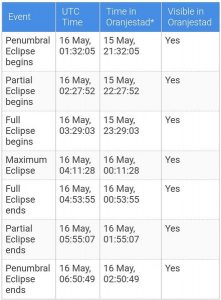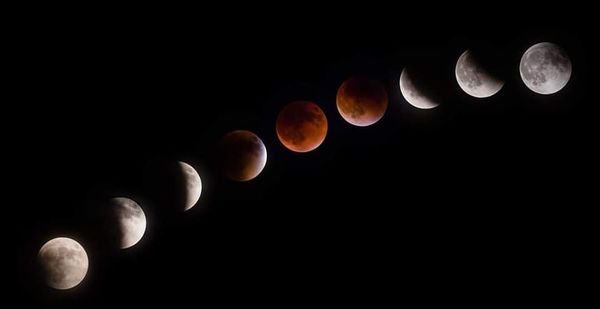The Moon will pass through the Earth’s shadow, creating a total lunar eclipse. The eclipse will be visible anywhere the Moon is above the horizon at the time, including from Africa, the Americas, Europe, and French Polynesia.

“A lunar eclipse happens when the Sun, Earth, and a full Moon form a near-perfect lineup in space, in what is known as syzygy,” says Diana Hannikainen, Observing Editor at Sky & Telescope. The Moon slides into Earth’s shadow, gradually darkening, until the entire lunar disk turns from silvery grey to an eerie dim orange or red. Then events unfold in reverse order, until the Moon returns to full brilliance. The whole process will take about five hours and 20 minutes. You only need your eyes to see the drama unfold, but if you have binoculars or a backyard telescope, they’ll enhance the view.
The events that happen during a total lunar eclipse are more complex and interesting than many people realize. The event has five stages, each with different things to watch:
First stage
The Moon’s leading edge enters the pale outer fringe of Earth’s shadow: the penumbra. You probably won’t notice anything until the Moon is about halfway across the penumbra.
The penumbra is the region where an astronaut standing on the Moon would see Earth covering only part of the Sun’s face.
Second stage
The Moon’s leading edge enters the umbra, the cone of Earth’s shadow within which the Sun’s completely hidden. You should notice a dramatic darkening on the leading edge of the lunar disk. With a telescope, you can watch the edge of the umbra slowly engulfing one lunar feature after another, as the entire sky begins to grow darker.
Third third
The trailing edge of the Moon slips into the umbra for the beginning of total eclipse. But the Moon won’t black out completely: It’s sure to glow some shade of intense orange or red.
The red umbral glow can be quite different from one eclipse to the next. Two main factors affect its brightness and hue. The first is simply how deeply the Moon goes into the umbra as it passes through; the center of the umbra is darker than its edges. The other factor is the state of Earth’s atmosphere. If a major volcanic eruption has recently polluted the stratosphere with thin global haze, a lunar eclipse can be dark red, ashen brown, or occasionally almost black.
Fourth stage
As the Moon continues moving along its orbit, events replay in reverse order. The Moon’s edge re-emerges into sunlight, ending totality and beginning a partial eclipse again.
Fifth stage
When all of the Moon escapes the umbra, only the last, penumbral shading is left. Some time later, nothing unusual remains.
From Aruba, the Lunar eclipse will be visible in the southern sky, weather permitting. It will start at 9:32PM and reach maximum at 12:11AM, where the maximum eclipse will last for 42 minutes. The Moon will regain total luminosity at 2:50AM (all times given in Aruba time).

















